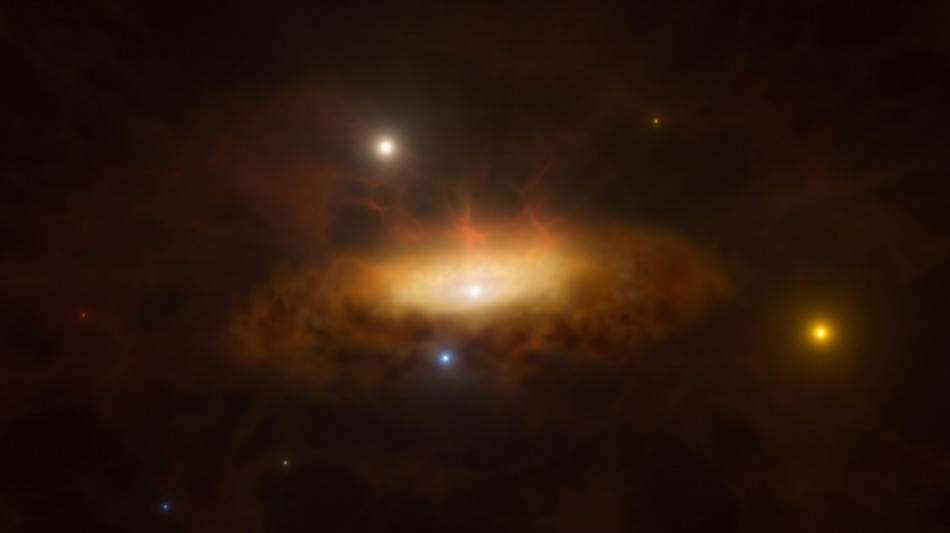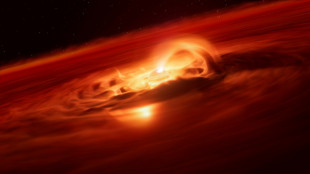
-
 Death toll from Indonesia school collapse rises to 37
Death toll from Indonesia school collapse rises to 37
-
OPEC+ meets with future oil production hanging in the balance

-
 Dodgers down Phillies on Hernandez homer in MLB playoff series opener
Dodgers down Phillies on Hernandez homer in MLB playoff series opener
-
Philadelphia down NYCFC to clinch MLS Supporters Shield

-
 Syria selects members of first post-Assad parliament in contested process
Syria selects members of first post-Assad parliament in contested process
-
Americans, Canadians unite in battling 'eating machine' carp

-
 Negotiators due in Cairo for Gaza ceasefire, hostage release talks
Negotiators due in Cairo for Gaza ceasefire, hostage release talks
-
Trump authorizes troops to Chicago as judge blocks Portland deployment

-
 Wallabies left ruing missed chances ahead of European tour
Wallabies left ruing missed chances ahead of European tour
-
Higgo stretches PGA Tour lead in Mississippi

-
 Blue Jays pummel Yankees 10-1 in MLB playoff series opener
Blue Jays pummel Yankees 10-1 in MLB playoff series opener
-
Georgia ruling party wins local polls as mass protests flare

-
 Depoortere stakes France claim as Bordeaux-Begles stumble past Lyon
Depoortere stakes France claim as Bordeaux-Begles stumble past Lyon
-
Vinicius double helps Real Madrid beat Villarreal

-
 New museum examines family life of Mexican artist Frida Kahlo
New museum examines family life of Mexican artist Frida Kahlo
-
Piccioli sets new Balenciaga beat, with support from Meghan Markle

-
 Lammens must be ready for 'massive' Man Utd scrutiny, says Amorim
Lammens must be ready for 'massive' Man Utd scrutiny, says Amorim
-
Arteta 'not positive' after Odegaard sets unwanted injury record

-
 Slot struggles to solve Liverpool problems after third successive loss
Slot struggles to solve Liverpool problems after third successive loss
-
Netanyahu hopes to bring Gaza hostages home within days as negotiators head to Cairo

-
 Ex-NFL QB Sanchez in hospital after reported stabbing
Ex-NFL QB Sanchez in hospital after reported stabbing
-
Liverpool lose again at Chelsea, Arsenal go top of Premier League

-
 Liverpool suffer third successive loss as Estevao strikes late for Chelsea
Liverpool suffer third successive loss as Estevao strikes late for Chelsea
-
Diaz dazzles early and Kane strikes again as Bayern beat Frankfurt

-
 De Zerbi living his best life as Marseille go top of Ligue 1
De Zerbi living his best life as Marseille go top of Ligue 1
-
US envoys head to Mideast as Trump warns Hamas against peace deal delay

-
 In-form Inter sweep past Cremonese to join Serie A leaders
In-form Inter sweep past Cremonese to join Serie A leaders
-
Kolisi hopes Rugby Championship success makes South Africa 'walk tall' again

-
 Ex-All Black Nonu rolls back the years again as Toulon cruise past Pau
Ex-All Black Nonu rolls back the years again as Toulon cruise past Pau
-
Hundreds of thousands turn out at pro-Palestinian marches in Europe

-
 Vollering powers to European women's road race title
Vollering powers to European women's road race title
-
Struggling McLaren hit bump in the road on Singapore streets

-
 'We were treated like animals', deported Gaza flotilla activists say
'We were treated like animals', deported Gaza flotilla activists say
-
Czech billionaire ex-PM's party tops parliamentary vote

-
 Trump enovys head to Egypt as Hamas agrees to free hostages
Trump enovys head to Egypt as Hamas agrees to free hostages
-
Arsenal go top of Premier League as Man Utd ease pressure on Amorim

-
 Thousands attend banned Pride march in Hungarian city Pecs
Thousands attend banned Pride march in Hungarian city Pecs
-
Consent gives Morris and Prescott another memorable Arc weekend

-
 Georgian police fire tear gas as protesters try to enter presidential palace
Georgian police fire tear gas as protesters try to enter presidential palace
-
Vollering powers to European road race title

-
 Reinach and Marx star as Springboks beat Argentina to retain Rugby Championship
Reinach and Marx star as Springboks beat Argentina to retain Rugby Championship
-
Russell celebrates 'amazing' Singapore pole as McLarens struggle

-
 Czech billionaire ex-PM's party leads in parliamentary vote
Czech billionaire ex-PM's party leads in parliamentary vote
-
South Africa edge Argentina to retain Rugby Championship

-
 'Everyone's older brother': Slipper bows out in Wallabies loss
'Everyone's older brother': Slipper bows out in Wallabies loss
-
Thousands rally in Georgia election-day protest

-
 Sinner starts Shanghai defence in style as Zverev defies toe trouble
Sinner starts Shanghai defence in style as Zverev defies toe trouble
-
Russell takes pole position for Singapore Grand Prix as McLaren struggle

-
 Robertson praises All Blacks 'grit' in Australia win
Robertson praises All Blacks 'grit' in Australia win
-
Government, protesters reach deal to end unrest in Pakistan's Kashmir


Massive black hole 'waking up' in Virgo constellation
A massive black hole at the heart of a galaxy in the Virgo constellation is waking up, shooting out intense X-ray flares at regular intervals that have puzzled scientists, a study said Friday.
Astronomers previously had little reason to pay any attention to galaxy SDSS1335+0728, which is 300 million light years from Earth.
But in 2019, the galaxy suddenly started shining with a brightness that turned some telescopes its way.
Then in February last year, Chilean astronomers started noticing regular bursts of X-rays coming from the galaxy.
This was a sign that the galaxy's sleeping black hole was waking from its slumber, according to the study published in the journal Nature Astronomy.
Most galaxies, including our home Milky Way, have a supermassive black hole squatting at their heart, like a spider in a web.
These invisible monsters gobble up everything that comes their way -- not even light can escape their almighty suck.
If an unlucky star swings too close, it gets torn apart.
The star's shattered material becomes a stream that spins rapidly around the black hole, forming what is called an accretion disc that is gradually swallowed.
But black holes can also go through long periods of inactivity when they do not attract matter.
And after a fairly uneventful period, the bright, compact region at the heart of galaxy SDSS1335+0728 has been classified as an "active galactic nucleus" -- and given the nickname "Ansky".
"This rare event provides an opportunity for astronomers to observe a black hole's behaviour in real time" using several X-ray telescopes, astronomer Lorena Hernandez-Garcia of Chile's Valparaiso University said in a statement.
- 'Pushes models to their limits' -
Ansky's short-lived X-ray flares are called quasiperiodic eruptions, or QPEs.
"This is the first time we have observed such an event in a black hole that seems to be waking up," Hernandez-Garcia said.
"We don't yet understand what causes them."
The current theory is that QPEs are linked to the accretion discs that form after black holes swallow stars.
But there is no sign that Ansky has recently feasted on a star.
And its flares are quite unusual.
"The bursts of X-rays from Ansky are 10 times longer and 10 times more luminous than what we see from a typical QPE," said Joheen Chakraborty, a PhD student at MIT and member of the research team.
"Each of these eruptions is releasing a hundred times more energy than we have seen elsewhere."
The intervals of 4.5 days between these blasts are also the longest ever observed, he added.
"This pushes our models to their limits and challenges our existing ideas about how these X-ray flashes are being generated," he said in the statement.
Astronomers have had to come up with some theories for what could be causing these strange bursts.
One was that the accretion disc was formed by gas getting sucked into the black hole, which only shoots out X-ray flares when a small celestial object such as a star crosses its path.
"Simply imagine a black hole and disc around it," Norbert Schartel, chief scientist of the European Space Agency's XMM-Newton telescope which has observed Ansky, told AFP.
Now imagine the star crossing the disc twice every time it orbits -- shooting out flares -- but at a particular angle which means "there is no real strong force to drag it in," he said.
X-ray astronomer Erwan Quintin told AFP that "for QPEs, we're still at the point where we have more models than data".
"We need more observations to understand what's happening."
L.Wyss--VB




